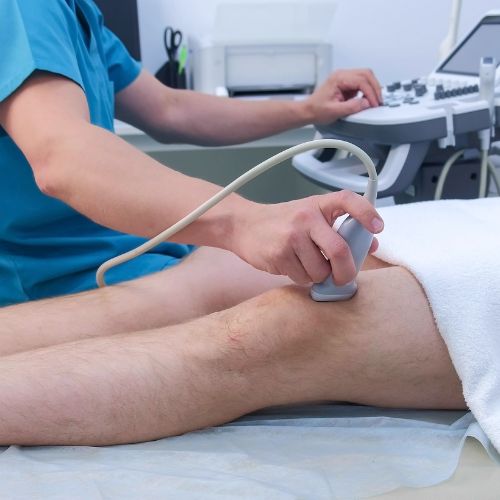Key Takeaways:
- Early testing for PAD is essential to prevent serious complications like limb loss and improve long-term outcomes.
- Initial assessment includes a physical exam and symptom review, followed by tests like the ankle-brachial index and Doppler ultrasound.
- Advanced imaging and blood tests help confirm diagnosis, assess severity, and guide personalized treatment plans.
Peripheral artery disease can significantly impact your quality of life, causing pain, limiting mobility, and potentially leading to severe complications like limb loss. Understanding how to test for peripheral artery disease is essential for timely diagnosis and treatment, potentially saving limbs and improving overall cardiovascular health.
What is Peripheral Artery Disease?
Peripheral artery disease (PAD) is a condition where arteries, typically in the legs, become narrowed and reduce blood flow. This can lead to symptoms such as leg pain during walking (claudication), cold feet, numbness, and sores that heal slowly or not at all.
Risk factors include:
- Smoking
- Diabetes
- High cholesterol
- High blood pressure
- Obesity
- Being over the age of 65

PAD is often caused by atherosclerosis—the buildup of plaque in artery walls that causes them to narrow and harden. However, it may also result from blood clots or physical trauma.
Left untreated, peripheral artery disease can lead to severe complications like gangrene and amputation.
Your Initial Assessment
The initial assessment for peripheral artery disease begins with a comprehensive medical history review focusing on symptoms, risk factors, and lifestyle. A physical examination follows, where one of our vascular surgeons looks for signs such as shiny skin, brittle toenails, and hair loss on the legs and feet.
Pulse checks are a crucial part of the assessment. Your provider will evaluate blood flow by feeling for pulses in various locations, including the groin, behind the knees, and ankles. Weak or absent pulses may indicate arterial narrowing or obstruction.
Visual inspection of the legs and feet is essential. Your doctor will examine the skin for color changes, temperature differences, and any wounds or ulcers. They may also check for signs of poor circulation, such as pallor when elevating the leg or redness when lowering it.
This initial assessment helps determine if further diagnostic tests, such as the ankle-brachial index (ABI) or imaging studies, are necessary.
How to Test for Peripheral Artery Disease: Advanced Tests

Your doctor has many options for how to test for peripheral artery disease. They primarily use the ankle-brachial index (ABI) test, which involves comparing blood pressure in the ankle and arm using inflatable cuffs and a Doppler ultrasound device.
Other methods include blood tests for risk factors and advanced imaging techniques like CT angiography for detailed artery visualization.
Ankle-brachial index (ABI) test
This primary screening tool compares systolic blood pressure in the ankle and arm using inflatable cuffs and an ultrasound. Your ABI score is calculated by dividing the higher ankle pressure by the higher arm pressure.
For patients with leg pain during activity, an exercise ABI test adds walking on an inclined treadmill to measure pressure changes post-exercise.
Doppler ultrasound
This painless, noninvasive test uses sound waves to visualize blood flow and detect plaque buildup in arteries. A technician applies gel and moves a transducer over the skin to assess blockages or reduced circulation, often combined with pulse volume recording to test for accuracy.
Blood tests
While no blood test directly diagnoses PAD, blood tests can check for risk factors that put you at a higher risk for atherosclerosis, which causes PAD. These tests can check for:
- Cholesterol
- C-reactive protein (CRP)
- Blood sugar levels to evaluate
Elevated results may prompt further vascular testing.
Early detection via ABI or Doppler ultrasound is critical, while advanced imaging refines surgical planning for complex cases. These methods collectively diagnose PAD severity, guide treatment decisions, and monitor progression.
Additional diagnostic tests
Healthcare providers aren’t limited to the above tools for testing for peripheral artery disease. PAD diagnosis expands beyond the ankle-brachial index to include angiography and the toe-brachial index (TBI). Angiography uses X-rays and contrast dye to visualize arterial blockages, guiding treatment decisions like angioplasty or stenting.
The TBI measures toe-to-arm systolic pressure ratios, which are particularly useful when ABI results are unreliable due to arterial stiffness (common in diabetes). Both tests enhance diagnostic accuracy, especially for calcified vessels or complex cases requiring surgical planning.
Schedule Your Free Vein Screening in Knoxville, Tennessee
Free vein screenings play a vital role in preventing, detecting, and treating peripheral artery disease by identifying early signs of vascular dysfunction. These noninvasive assessments evaluate factors associated with the development of PAD, such as:
- Blood flow irregularities
- Venous insufficiency
- Clotting risks
Early detection allows for timely lifestyle modifications like smoking cessation and exercise or medical interventions to slow disease progression. Screenings also highlight risk factors like diabetes or hypertension, enabling proactive management to reduce PAD-related complications such as ulcers or limb ischemia.
APEX Vascular excels in providing these screenings through our patient-centered approach. Our interdisciplinary team combines advanced diagnostic tools like Doppler ultrasound with extensive vascular expertise to deliver accurate assessments.
By offering free access to vein screenings, we remove financial barriers and encourage proactive vascular health monitoring in alignment with our mission to improve long-term outcomes. At APEX Vascular, we ensure that screenings are stress-free and informative, while our commitment to high-quality care guarantees follow-up support.
You can trust our experienced specialists to guide you from screening to solution with compassion and precision.

Peripheral artery disease assessment includes reviewing medical history and conducting a physical exam for signs like shiny skin or weak pulses. Advanced tests like the ankle-brachial index or Doppler ultrasound may be used. APEX Vascular offers free vein screenings in Knoxville, promoting early detection and tailored care.
APEX Vascular is a vascular surgery and vein center with locations in Knoxville, Lenoir City, Crossville, Decatur, Harrogate, and Sevierville, TN. We are dedicated to delivering personalized, high-quality care that goes beyond medical treatment. Our exceptional vascular staff, boasting extensive experience in vascular surgery, works tirelessly to elevate the standards of patient care and contribute to your overall well-being. Visit us online or call us at 865-562-3232 to request an appointment today!









